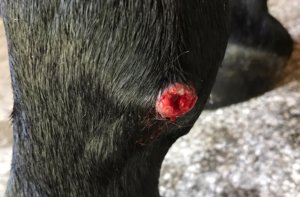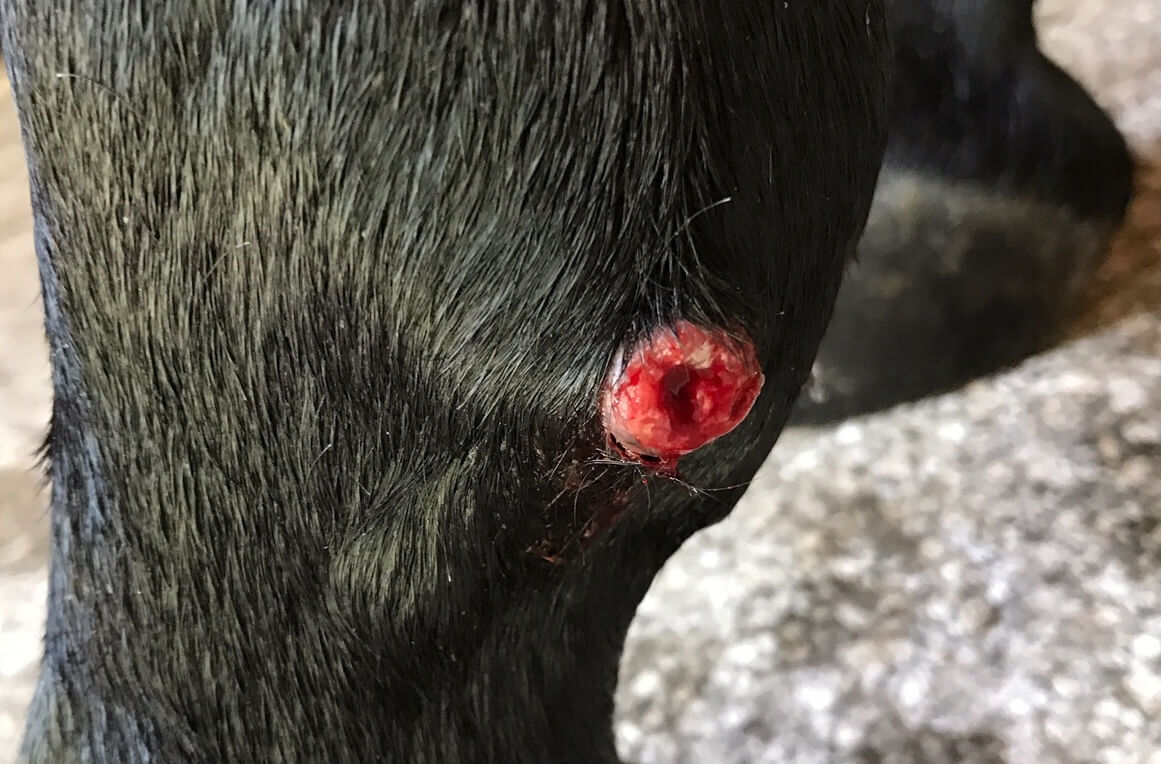Stomach Worms Gone Astray
By Eleanor Blazer
The mare lived in the perfect home: balanced diet, access to good quality forage, fresh clean water always available, adequate exercise and turnout time with her friends. Vaccinations were kept up-to-date, the farrier came on a regular schedule, fecal egg counts were conducted to check for internal parasites, and her owner was at her beck and call.
So how did she end up with a summer sore on her fetlock?
It all started with a little bump which quickly turned into an ugly wound. The wound was not just a scrape – it was an ulcerative cutaneous granuloma. Which means the wound was inflamed and a mass of cellular tissue was developing in response to the infection. The cause was a stomach worm gone astray.

Summer sores are caused by the abnormal depositing of the Habronema or Draschia stomach worm larvae (immature worms) into a skin abrasion, or on the delicate skin around the mouth, eyes, genitals, ears and mid-line. House, stable and face flies are the carriers – transporting the worm larvae from the manure pile to the horse. The larvae cannot mature outside of their normal incubation location – the equine stomach, but they can exacerbate an existing abrasion, resulting in a sore that is hard to heal.
The mare acquired a summer sore on her fetlock – a location that is prone to small cuts and abrasions. Other prime lower leg locations for summer sores are the coronary band and under the fetlock (behind the pastern) where they can be hard to detect.
When such a sore is discovered, a veterinarian should be consulted as several serious diseases present the same symptoms. Tumors, proud flesh (excessive growth of tissue on a wound), fungal infections or allergic reactions have to be ruled out – and treated appropriately. The veterinarian may need to conduct a biopsy to detect the presence of larvae.
Treatment starts with deworming the horse with a larvicide which contains ivermectin or moxidectin. Studies have shown marked clinical improvement within seven days of a single treatment, with complete healing in approximately five weeks. Some horses may need multiple doses due to inadequate response or reinfection. The veterinarian may also recommend some of the deworming agent be applied directly to the sore, which will help kill the larvae. Other deworming agents are not effective against the Habronema or Draschia parasite.
Along with deworming, the veterinarian will recommend a topical treatment of a glucocorticoid and DMSO mixture applied directly to the sore. If possible, the area should be bandaged to protect the wound. Corticosteroids may be prescribed if the horse won’t leave the area alone due to itching and rubbing. Secondary infections may warrant the treatment with an antibiotic or antimicrobial.
Severe cases may require the sore to be frozen with liquid nitrogen. Proud flesh may also have to be surgically removed if it develops.
Prevention takes the form of fighting on three fronts – controlling the stomach worm, controlling the flies and treating wounds immediately.
Controlling Stomach Worms
All horse owners are aware of the resistance stomach worms have developed against deworming agents due to overuse of those products. The practice of regularly checking fecal egg counts and not deworming unless warranted is the current recommended deworming protocol.
Unfortunately, the Habronema or Draschia stomach worms are hard to detect with a fecal egg count test. Therefore the American Association of Equine Practitioners (AAEP) recommends once or twice-yearly treatments with ivermectin or moxidectin to specifically target these parasites. The old schedule of deworming every six weeks is not recommended. Consult your veterinarian for a deworming program designed for your individual horses based on need.
Controlling Flies
Controlling flies starts with manure management. Fly-breeding sites must be eliminated by removing manure and soiled material several times a week. If the stable uses a compost pile the internal heat must be high enough to kill the eggs.
Creating a barrier between your horse and the flies by using insecticides, repellents, masks, sheets and leg protection will help protect open wounds and sensitive areas from infestation. The AAEP also suggests using feed-through insect growth regulator to deter the growth and development of flies in the manure. Releasing parasitic wasps, which eat immature flies, will also aid in the fight to control flies.
Prompt Wound Treatment
Be vigilant on detecting and treating wounds – no matter how small. Cleaning and applying a protective coating will aid in preventing flies from depositing worm larvae in the wound. But don’t think it can’t happen to your horse – even with all three of the preventative measures in place the mare still ended up with a summer sore. Her owner spotted the sore immediately, so it was treated, remained small, and healed quickly.
Once the sore is healed do not relax. Studies have shown a horse that has battled a summer sore has a high chance of reoccurring summer sores.
* Earn Professional Certification as Horse Trainer, Stable Manager or Riding Instructor. All courses are online. Visit www.equinestudiesinstitute.org for information.
©2019 The Way of Horses

Eleanor Blazer was raised training and caring for horses. She learned to ride and care for the horses her family bought and sold. Many of these horses required improved nutrition when they arrived for training. Eleanor’s experience and research has benefited both horses and horse lovers in the field of equine nutrition. An equine nutrition consultant, based in Bulverde, Texas, she keeps busy doing equine nutrition consultations, conducting seminars, and speaking to youth groups about horse care and nutrition. Eleanor is the author of the syndicated column The Way of Horses. She has more than 20 years experience helping and being a mentor to those wanting to know how to provide the very best care and nutrition for our special friend – the horse.






